Protein interaction underlying healthy brain development revealed

Original story from the Salk Institute (CA, USA).
Researchers capture first-of-its-kind video of dynein–Lis1 protein interaction, supporting future drug development for neurological disorders.
Our cells rely on microscopic highways and specialized protein vehicles to move everything – from positioning organelles, to carting protein instructions, to disposing of cellular garbage. These highways (called microtubules) and vehicles (called motor proteins) are indispensable to cellular function and survival.
The dysfunction of motor proteins and their associated proteins can lead to severe neurodevelopmental and neurodegenerative disorders. For example, the dysfunction of Lis1, a partner protein to the motor protein dynein, can lead to the rare fatal birth defect lissencephaly, or ‘smooth brain’, for which there is no cure. However, therapeutics that target and restore dynein or Lis1 function could change those dismal outcomes – and developing those therapeutics depends on thoroughly understanding how dynein and Lis1 interact.
New research from the Salk Institute and UC San Diego (both CA, USA) captured short movies of Lis1 interacting with dynein. The movies allowed the team to catalogue 16 shapes that the two proteins take as they interact, some of which have never been seen before. These insights will be foundational for designing future therapeutics that restore dynein and Lis1 function, since they shine a light on precise locations where drugs could interact with the proteins.
“I’ve always been interested in motor proteins, but dynein is especially fascinating to me because it’s the only motor protein that can move toward the cell’s center,” says co-corresponding author Agnieszka Kendrick (Salk). “The impressive tools we have today in the lab made it possible for us to create a movie of dynein and Lis1 interacting in real time. Having this detailed view of their stepwise partnership will help us find ways to restore their activity in neurodevelopmental and neurodegenerative diseases.”
 Seeking structure: an insight into cryo-EM, structural biology and drug development
Seeking structure: an insight into cryo-EM, structural biology and drug development
We spoke to two scientists – who use cryo-EM to resolve questions of structure and function – about how they are working to improve cryo-EM technology as well as extract more from their electron microscopy data.
Background: unlocking dynein
Dynein is made up of two identical halves that each contain a ‘stalk’ that attaches to the microtubule, a ‘tail’ that attaches to whatever is being hauled by the protein and a ‘motor’ that powers its travel. The physical movement of dynein looks a bit like walking – as the motor uses up cellular fuel called ATP, the stalks take turns detaching, swinging forward and reattaching to the microtubule below.
Since dynein is a one-way ticket toward the valuable genetic vault that is the nucleus, its activity is tightly regulated. When it’s not carting anything, dynein detaches entirely from the microtubule highways and floats freely in a locked-up state. Over the last few years, Kendrick and colleagues have been hard at work piecing together how dynein becomes unlocked.
So far, their studies have revealed that Lis1 acts as a key, wedging itself into dynein’s structure and unlocking it into an open shape. However, these insights were based on still images of dynein and Lis1, taken sporadically across various stages of their interaction. While there was a lot to learn from these freeze frames, a deeper understanding of how the two proteins interact could only come from watching them in action.
 How does Alzheimer’s disease affect tissues other than the brain?
How does Alzheimer’s disease affect tissues other than the brain?
A new study highlights how both neuronal and peripheral tissues become disrupted in Alzheimer’s disease.
Key discoveries: How Lis1 and dynein interact
“Our approach to imaging dynein and Lis1 is more comprehensive than any previous study on this protein,” says co-corresponding author Andres Leschziner (UC San Diego). “By capturing movies rather than pictures, we confirmed 16 detailed, 3D shapes that dynein takes as it interacts with Lis1 – several of which are entirely unique to our study.”
The team used a yeast model to capture dynein and Lis1, since – unlike human cells – yeast cells can survive when dynein and Lis1 levels are altered. And because dynein’s structure is functionally the same in both human and yeast cells, what we learn about yeast dynein can still be applied to human dynein.
Using this yeast model, the researchers isolated dynein and Lis1 and decreased the temperature dramatically to slow down dynein activity. They then captured a high-definition 3D movie of dynein interacting with Lis1 that could represent the timeline between dynein’s locked and unlocked states using time-resolved cryogenic electron microscopy (cryo-EM).
Cryo-EM uses beams of electrons to construct a 3D image of a molecule with down-to-the-atom detail. Previous studies have used cryo-EM and other imaging methods to construct images of dynein in its locked and unlocked states. The time-resolved component, however, is new. Instead of capturing a single structure at a single time point, time-resolved capture identifies different structures over time to create a movie. This allowed Salk and UC San Diego scientists to track sub-second changes in dynein’s structure, explaining the step-by-step process it takes to transition from locked to unlocked states.
The new video shows that the first step to activating dynein involves Lis1 attaching to dynein’s motor subunit. Like dynein, Lis1 is also made up of two identical halves. In this first interaction, one half of Lis1 attaches to dynein, in turn relieving dynein of its locked state and turning its motor on by altering its shape to facilitate more rapid, efficient utilization of ATP. Turning on this ATP-fueled engine is key to initiating dynein’s ability to travel on the cell’s microtubule highways.
Then, the second half of Lis1 attaches itself to dynein – this time on the stalk. This second Lis1 interaction completes the activation and solidifies dynein’s unlocked state. It also further increases dynein’s motor activity, revving it up for action.
 How it works: the dynamic G protein-coupled receptor
How it works: the dynamic G protein-coupled receptor
A GPS-like technique has been used to track G protein-coupled receptor movement, revealing how these essential receptors function.
Looking ahead: repairing Lis1 and dynein dysfunction in developmental and neurological disorders
“These findings certainly take us closer than we’ve ever been to understanding why Lis1 dysfunction has such a devastating effect on dynein activity, and how that contributes to developmental and neurological disorders down the line,” says Kendrick.
The new high-resolution, 3D structural insight into dynein and Lis1 could pave the way for treating their dysfunction in neurodevelopmental and neurodegenerative diseases. Future studies can explore how different mutations to Lis1 affect its interactions with dynein, and how this contributes to lissencephaly and other rare genetic disorders. Ultimately, the more that’s known about the physical structures of these two proteins, the easier it will be to create drugs that ‘fit’ into those structures and restore their activity.
This article has been republished from the following materials. Material may have been edited for length and house style. For further information, please contact the cited source. Our press release publishing policy can be accessed here.